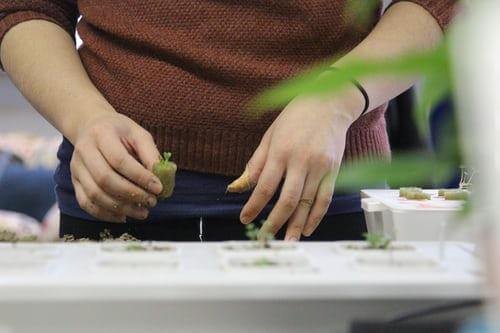To set up a hydroponic garden, you can start by preparing a simple bucket system that can fit one plant in it. Then, start your hydroponics system in a location where the plants will receive six hours of daylight per day. This will provide all the lighting that plants need to thrive. It is also important to consider power outages. If you want to keep your hydroponic garden going year round, here are some tips.
Proper lighting
After you buy indica seeds online, when choosing a light source for your hydroponic garden, you should consider the size of your plants. As a general rule, place a light about twenty inches away from the plants. However, the exact distance depends on the type of bulb you choose. A typical HID light, for example, is twenty inches away. LED bulbs, on the other hand, are about six inches away. If you like growing weed inside without lights and different types of greens, you may want to use natural sun lights.
Choosing the right kind of lighting for your hydroponic garden is essential to ensuring that your plants grow quickly and healthy. You should use lights with the correct balance of red, blue, and white light. Most hydroponic experts recommend a distance of four to six inches for their plants. While fluorescent lights can produce a large amount of light, they are not very efficient. Around 50% of fluorescent light must be reflected back toward the growing surface.
Temperature and humidity
When growing hydroponically, the ideal temperature and humidity for seedlings and cuttings is between sixty and seventy percent. In the early stages of plant development, humidity may be higher and a decrease in the amount of water may be needed. By harvest, the ideal humidity is around forty to fifty percent. A plain thermometer placed under the grow lights should be sufficient to monitor these two aspects. Similarly, a good general rule is to maintain a temperature difference of 10 degrees Celsius during the day and 5 degrees Celsius at night.
While this sounds like an oxymoron, it is important to keep your plants at the correct temperature. Too high of a temperature or too low of a humidity can lead to problems with pH balance, nutrient lockout, and a decreased absorption rate of nutrients. When the temperatures are too high, plants tend to transpire water. If the temperatures are too low, plants will slow down growth and nutrient absorption. A high humidity level will cause plants to go dormant.
Growing medium
When setting up a hydroponic garden, the growing medium that you will use can make or break your hydroponic system. There are many options available, including soil, pebbles, rockwool, and rockwool-based blends. Perlite, for example, is a volcanic rock that is a good choice for hydroponics, as it has a high AFP and CEC, and is relatively lightweight. It can be recycled several times and is good for root aeration. However, because it is a light, porous material, it is not suitable for a full submerging growing medium.
One thing to keep in mind is that the growing medium will need to be cleaned and sterilized before and after every crop. In addition, you will also need a mesh pot, which is inexpensive and easy to maintain. You’ll also need to make sure that you have a mesh pot for your growing medium, because there are several different kinds available. But regardless of your choice, the growing medium is the most important part of your hydroponic system.
Power outages
Power outages are often a problem when hydroponically growing your crops. You can try using a phone charger or garage inverter, or install a backup generator to provide enough power during an outage. Also, you can look into using a gas powered generator to supply enough power to keep your hydroponic system running. Those are both excellent options if you live in an area that suffers from frequent power outages.
Another potential hazard is fire, particularly for water-based systems. Even professional hydroponic growers warn that water-based systems can pose a fire hazard. Since this type of hydroponics relies on electrical hookups, lighting, and other appliances, failure in one of these appliances can cause a fire and ruin a crop. It’s important to follow manufacturer guidelines when setting up a hydroponic system, and be sure to follow all guidelines regarding power sources.
Water saving methods
There are many different ways to save water when growing plants in hydroponic systems, and one of the most efficient is to reuse wastewater. This recycled water is perfect for hydroponics and can help alleviate the pressure on groundwater. You can also use it to fertilize your plants. Water saving methods for hydroponic gardens can also include using composts to add nutrients to your growing medium. A hydroponic garden can help you save water without sacrificing quality.
One of the biggest benefits of hydroponic farming is the fact that it uses less water than soil and is virtually weed-free. It’s also possible to grow hydroponic plants all year round, even in Minnesota! In the winter, short-season crops like strawberries and leafy greens are excellent indoor choices for growing in hydroponic systems, and in the summer, cucumbers and peppers are wonderful. Many commercial growers use this system, too, to save space and money.


